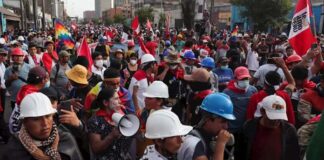Latin America’s Turbulent Transitions
By Roger Burbach, Michael Fox and Federico Fuentes
Zed Books $34.95
The new millennium has seen the rise of new left governments across Latin America, from the more radical governments in Venezuela and Bolivia, to others such as Ecuador and Brazil. This book, a joint effort by prominent academics in the area Roger Burbach and Michael Fox with Green Left Weekly’s Federico Fuentes, sets out to examine Latin America’s left governments and their promise of “21st century socialism”.
Latin America is the continent where the rebellion against neo-liberalism has gone deepest. For two decades the economic policies imposed by the US and international institutions like the IMF and World Bank ravaged the continent. Cuts to social spending and widespread privatisations led to increased inequality, and economic growth slumped to just 0.5 per cent a year between 1980 and 1999.

The result was an explosion of social movements demanding an end to neo-liberal policies. Venezuela produced the Caracazo urban uprising of 1989 against cuts to government subsidies that sent the price of gas and public transport soaring. It was violently repressed, with 3000 people killed. The city of Cochabamba in Bolivia rose up in the “water wars” against privatising water in 2000, and mass marches on the Presidential palace toppled two presidents in 2003 and 2005.
The book situates the new left governments as a product of these waves of mass struggle. It looks at the devastating impact of neo-liberalism and examines the key left governments in separate chapters that examine what they have done while in power.
In Venezuela, Bolivia and Ecuador in particular it details how the new governments have significantly boosted government spending on healthcare, welfare programs and social services. The result has been a major reduction in poverty. In Venezuela the number of people in poverty dropped 24.5 per cent between 2003 and 2006, and fell from 38.2 to 25.4 per cent of the population in Bolivia between 2005 and 2010.
This has largely been funded by income from nationalised oil industries and higher taxes on mining.
It is well known that higher government spending in Venezuela has relied on income from the country’s enormous oil wealth, which provides close to half of government income. It is estimated to have the largest oil reserves in the world, greater even than Saudi Arabia.
Although the book does not really acknowledge the extent to which government revenues have relied upon it, there has been a minerals boom across the continent, powered by China. Between 2004 and 2008 growth across Latin America averaged 5.3 per cent a year, before dipping briefly as a result of the global economic crisis.
Even left governments like those in Bolivia and Ecuador have been strong supporters of expanding the mining sector in order to boost government revenues. The book examines the criticism that they are continuing an “extractivist” strategy for economic growth that is no different to other capitalist governments.
Marc Beker, who writes the chapter on Ecuador, levels this charge against the left-wing government of Rafael Correa, arguing that he has, “frequently clashed with many on the traditional left and other members of Ecuador’s well organised social movements”.
Correa has been willing to send in the military to crush indigenous protests against new mining developments and prosecuted hundreds of activists under terrorism laws. However, it is not clear that the editors agree with Beker’s assessment, as they include Ecuador in their list of the countries that are moving in a more radical direction.
But the authors clearly defend the governments of Bolivia and Venezuela, both because of the scale of their nationalisations and their wider efforts to encourage mass popular democracy and new economic models.
The chapter on Venezuela illustrates the development of the revolutionary process there but it is also honest about some of the problems faced in driving the process forward.
The new government spending programs in areas like health have often created a new layer of bureaucrats that have enriched themselves from corruption. This “boli-bourgeoisie” as it is often known have worked to obstruct popular power, such as workers’ control in the factories, as well the implementation of more radical government decisions.
The passing of Hugo Chavez, who died after the book was completed, has shown that the “boli-bourgeoisie” may threaten the very future of the revolutionary process. His successor Nicholas Maduro beat the right-wing opposition candidate by a narrow 1.5 per cent, or just 224,000 votes, to retain the presidency.
While the book depicts the revolutionary process as still moving forward as a result of ongoing nationalisations, many left-wing activists within Venezuela seem to believe that the process of self-organisation from below capable of transforming the country has stalled.(1)
When it comes to Bolivia, the book vastly overstates the government’s radicalism. As in some of Fuentes’ other writings, the account relies heavily on the claims of Vice President Alvaro Garcia Linera, who it describes as “the leading theorist of the new Bolivian revolution”. But, Linera has described the government’s aim as building an “Andean capitalism”, as socialism is impossible in the short term and said that “Bolivia will still be capitalist in 50 or 100 years”.
One of the government’s key moves has been the re-organisation of most of Bolivia’s gas companies along with tax increases so that private companies can only keep 18 per cent of production value and the government takes the remaining 78 per cent. However these changes did not really amount to nationalisation, rather the government re-negotiated existing contracts with the multinationals without taking over their gas installations.
Government revenue has surged, but this has been helped by the large growth in export volumes and gas prices. The amount of gas exported more than doubled between 2005, the year before Morales took office, and 2012, and total export income has grown from $1.5 billion to $5.5 billion.
The Bolivian government is presented as a government of the social movements, and while it is true that most movements do support the government this leads the chapter to play down conflict between the government and the workers’ and indigenous movements. Many protests are dismissed as representing sectional interests. This is particularly unconvincing when the main source cited for the claim is a senior government minister.
These conflicts included major protests against government efforts to cut gas subsidies in 2010 that forced up transport prices, something that was in line with IMF advice, as Jeffrey Webber, the left-wing academic and Bolivia specialist notes. The government backed down but left open the prospect of cutting the subsidies in the future. In 2010, there were strikes demanding higher wages, and recently there have been large strikes by miners, health workers, teachers and university staff demanding higher pensions. The push to expand mining development has also produced clashes with indigenous groups whose lands are threatened, mostly famously the plan to build a highway through the TIPNIS area.
The book’s argument that the revolutionary process is moving forward is also justified by the claim that, “none of these protest movements put forth any serious proposals or a program that posed a political alternative to the MAS government”. But the fact that there has been no mass political party to the left of MAS hardly proves that such a political project is not needed. The argument implies that mass parties simply materialise when social interests demand their existence. But as Karl Marx stressed, the existence of classes with their own distinct interests is an objective question, not only a subjective question of whether they have fully come to understand those interests.
These issues stem from a deeper problem in the book’s political framework—its understanding of the capitalist state and how to build socialism.
Socialism of the 21st century
The authors rightly point to the importance of Hugo Chavez’s declaration at the World Social Forum in 2005 that his aim was to reinvent socialism in the 21st century, and the discussion this has opened up about the continuing relevance of socialism today.
They see at least some of the countries discussed as “emerging socialist societies” that have “implemented important transformative reforms”.
Yet the book is distinctly unclear about what socialism is and how to get there. This is unfortunate given the different competing conceptions of socialism and the need (which they acknowledge) to rescue it from association with the Stalinist state-controlled economies.
Marta Harnecker’s summary of “five key components” of socialism is offered as the book’s definition. Among these are social ownership of production “organised by the workers” and decentralised participatory planning. But it is not clear which “components” are more important or how they fit together.
This is complicated further by the depiction of Cuba as already a fully-fledged “socialist society” and even the assertion that China and Vietnam are, or at least once were, socialist countries.
This fuzziness is a problem for activists and social movements in Latin America faced with the issue of relating to any of the new left governments. If the new governments are capable of taking Latin America towards socialism and completely transforming society, then there is no need to form an independent revolutionary organisation, and movement activists are justified in joining the governments to help implement their policies.
And it also carries wider implications: if Latin America has been at the forefront of the struggle against neo-liberalism then it must provide lessons for the left all over the world. Turbulent transitions thinks the lesson is that voting in a left-wing government through parliamentary elections can be the path towards socialism. This view dovetails with the enthusiasm for broad left parties like Syriza in Greece, which similarly advocates a government of the left as a way to reverse Europe’s austerity agenda.
The Marxist view of socialism, and the route to a socialist society, rests on which class holds power. A socialist revolution can take place only when the working class seizes power from the old ruling class under capitalism.
As Marx himself put it in the Communist Manifesto, “the first step in the revolution by the working class is to raise the proletariat to the position of ruling class”.
The lesson Marx drew from the Paris Commune in 1871, reaffirmed by Lenin in the Russian Revolution of 1917, was that this requires destroying the old capitalist state. In its place would be a workers’ state based on workers’ councils, made up of delegates directly elected from the workplaces and subject to immediate recall. Such organs of direct democracy have begun to be formed on numerous occasions during high points in class struggle—from Russia in 1917 to Spain in 1936, Chile in 1973, and Iran in 1979. In a slightly different form, based on community assemblies, organs of popular power in El Alto, Bolivia were formed to organise the near insurrectionary mobilisations in 2002 and 2005 that brought down successive neo-liberal governments.
Within the state
Yet Turbulent Transitions argues that the capitalist state can be an instrument of socialist transformation, claiming that, “In recent years the popular movements [in Latin America] have sought to alter the state, to make it responsive to their interests and needs.”
But the states in Bolivia, Venezuela and throughout Latin America remain capitalist states. The new left governments have delivered reforms, but they continue to promote capitalist development. So in Venezuela outside the oil sector the bourgeoisie continue to make healthy profits and the state has done little to challenge their wealth. In Bolivia and elsewhere the government has been at pains to encourage private investment, particularly in mining.
These efforts make clashes with workers, peasants and the poor inevitable—because the governments continue to serve opposing capitalist interests. They are not whole-heartedly “governments of the social movements” on the side of workers and the poor.
Turbulent transition’s mistaken view of the state also means that it ignores the way in which the new left governments have served to co-opt and demobilise the movements from below.
This can be seen in the way activists and social movement leaders have been drawn into helping to implement new social programs, like the misiones in Venezuela. As a result, activists now being paid, or having their projects funded by the state will come to see it as “their” government, and can more easily be drawn into defending its unpopular actions. When these states remain capitalist, as even the authors admit, this means demobilising the fight to move beyond capitalism.
Bolivia is an important example. As Jeffrey Webber wrote, “the left-indigenous insurrectionary period between 2000 and 2005 did indeed amount to a revolutionary epoch” that could have opened the way to a social revolution.
Chris Harman wrote in July 2005, that there were reports, “of general strikes; of columns of peasants marching on the city; of the occupation of oil wells and airports; of striking miners handing sticks of gelignite to striking teachers to throw against police lines; of attempts to invade the presidential palace… Yet they also tell of a ‘truce’ between the two sides, with an end to the strikes and the departure of demonstrators from La Paz.”
Future President Evo Morales argued to accept a compromise to hold elections later that year, and the movement was not united in understanding the possibility of taking power into its own hands.
In the months following, “politics shifted from the streets to the electoral terrain” and “we witnessed the common turn toward a dampening of revolutionary possibilities and social movements demobilized as a moderate political party came to office”, writes Webber.
The reforms that the new left governments have clearly implemented need to be defended against any right-wing backlash, such as the coup attempts against Chavez or the effort by sections of the corporate elite in Bolivia to secede and divide the country.
But a consistent effort to both demand further reforms, and deepen the revolutionary process, requires a revolutionary perspective within the movements, and the working class, based on maintaining political independence from the capitalist state.
The victory of socialism requires the building of new institutions of mass popular democracy strong enough to replace the existing capitalist states.
Turbulent Transitions provides a wealth of information about Latin America’s “pink tide” of new left governments. But it does not present a clear argument about the path towards socialist change.
James Supple
Notes
1 See for instance the Historical Materialism roundtable with revolutionary activists and academics on Veneuzuela, “The Bolivarian Process in Venezuela: A Left Forum” Historical Materialism 19.1 (2011) 233–270





